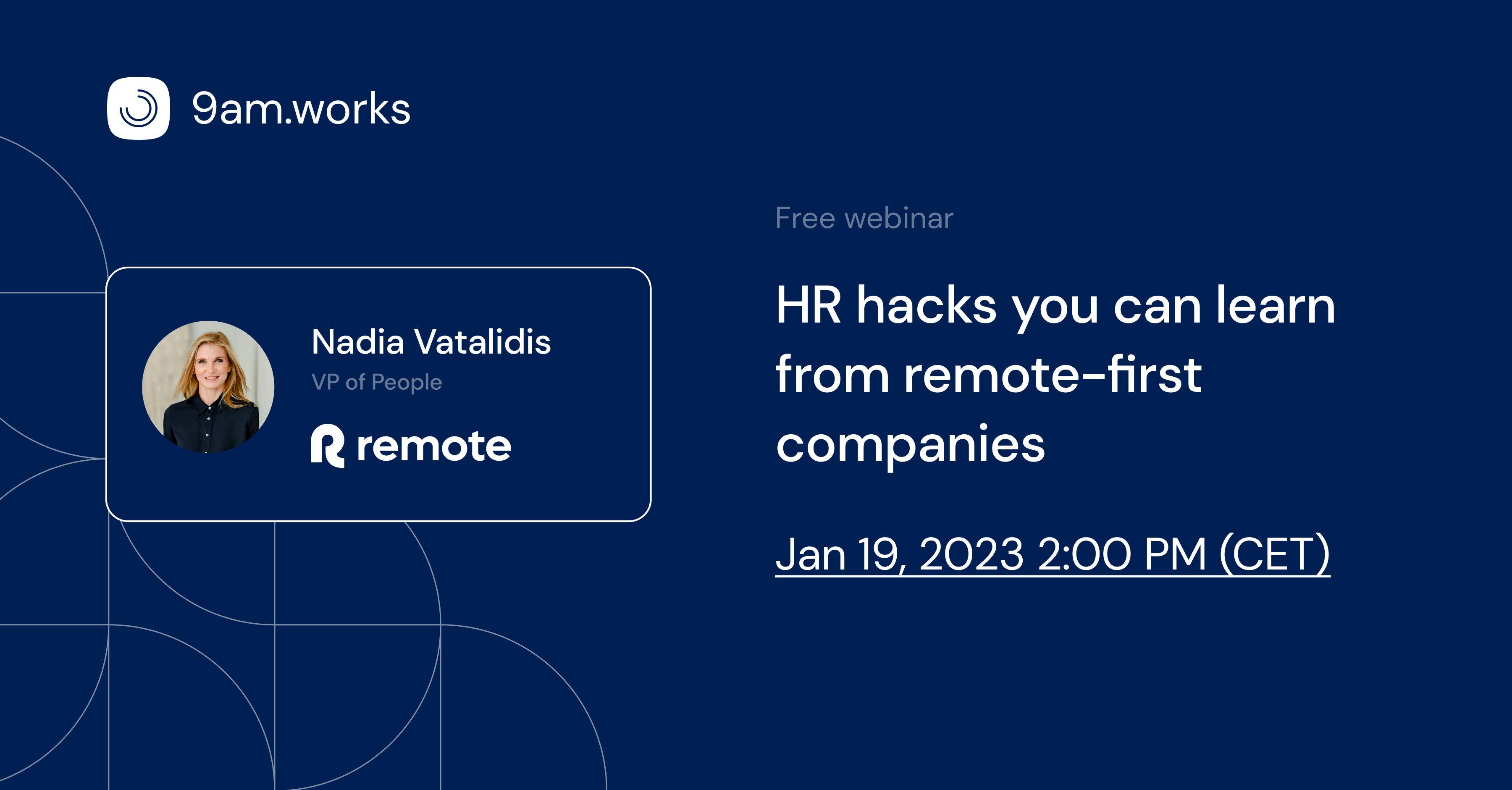What can we all learn from remote-first companies? On January 19th, 2023, we invited Nadia Vatalidis, VP of People at Remote, to discuss this topic. With a lot of experience at remote-first companies like GitLab and Remote, she’s the perfect person to explain why the set-up and processes of remote-first companies are beneficial for any company - remote, hybrid or in-office.
Remote-first practices help everyone
Some people want to work remotely, some prefer hybrid work, and some want to go to an office every day. To meet all of these needs, a hybrid set-up will be the future for a lot of companies. But Nadia believes that even in an office-only environment, it can be interesting to include some practices of remote-first companies. They help teams to be more efficient, inclusive and self-reliant.
The crucial part is to purposefully include the practices instead of forcing them, as many companies had to do at the beginning of the pandemic. Nadia has shared 5 pillars of remote-first with us.
Watch the video to see her explain them:
Pillar 1: Documentation
Good documentation is an important basis for any company, but it becomes even more essential for remote-first companies. It is the knowledge base that is always available, no matter where and when a team member is working. That way, it not only helps everyone to solve problems on their own, it also increases knowledge sharing and understanding.
It is not always easy to start a documentation from scratch if you haven’t focused on it before. Nadia has shared some tips for approaching it:
- Document whatever you are working on at the moment, if it’s a process of general importance for the company or team.
- When someone asks a question, try to respond by sharing a link to the documentation. If it doesn’t exist, create it.
- Ask recent hires what documentation they were missing in their onboarding process.
It can be a good idea to make parts of the documentation public because it helps other companies, and it gives prospective employees the opportunity to get an inside view. For example, there is a public Remote Handbook with a lot of information about processes at the company.
Pillar 2: Async collaboration
According to Nadia, efficiency can increase dramatically when teams use asynchronous collaboration. That is because it reduces time spent in inefficient meetings, and it promotes a mindset of solving problems on your own instead of always asking your team lead for the right approach. Of course, the basis for this is good documentation, so information is available at all times.
Nadia’s advice for implementing async collaboration:
- Don’t have the expectation that every message has to be answered immediately. That allows for more focused work and more meaningful responses because people think about their reply instead of going into quick-fixing mode.
- Avoid last-minute meetings, except for emergencies. If you want to share your thoughts without using writing, consider voice messages or short video recordings, for example with Loom.
- Cancel meetings without an agenda, except for regular 1-on-1 meetings.
Use speedy meetings with a maximum length of 25 minutes if a meeting is needed. - Normalize work blocks or no-meeting blocks. This can work out in an office too by using signs to show others you don’t want to be disturbed. That could be actual signs or clues like wearing noise-cancelling headphones or closing your office door.
Pillar 3: Processes and tools
Clear processes and the right tools help everyone to do a better job. It’s important to make sure remote people have the same options as people in the office when it comes to tool access or opportunities for social interactions. For example, you might consider adding calendar blockers for the team to meet and interact.
The tools that are used should be as simple and accessible as possible to make sure they are inclusive for all team members. It’s important to be aware of disabilities that could make it hard to use some of the tools, and to find different options.
Pillar 4: Flexibility
According to a recent survey by Remote, flexibility is one of the things employees value and look for the most in their work. Of course, the first thing that comes to mind in the context of remote work is the option to work from anywhere. But it’s not just about the location. For a lot of people, flexible working hours are equally important. This is something that any company can offer, even if they require their workforce to come to the office.
The same is true for allowing employees to decide how they want to work. An aspect of this is letting them choose their equipment, another is giving them freedom in choosing their working style, as long as it’s in line with company culture.
Flexibility in the types of benefits is interesting too. In different life stages, employees might value different benefits. A survey is a great way to find out what makes people happy and what has lower priority for them.
Pillar 5: Decision-making
Top-down decisions without explanations are often the source of failure. This can be even more true in a remote set-up, where people might feel like being dictated what to do without any way to gain insights or influence. They want to be part of ideas and decisions. According to Nadia, leaders should take feedback seriously and do surveys to learn about their team's opinions. It will never be possible to use every idea, but being open paves the way for more creative approaches and can be great for team motivation.
Here you can find the whole webinar including a Q&A session with Nadia.




